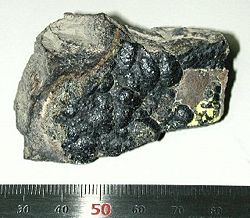| Uraninite | |
|---|---|
 |
|
| General | |
| Category | Mineral |
| Chemical formula | uranium oxide, UO2 |
| Identification | |
| Color | Black or brownish |
| Crystal habit | Massive, botryoidal, granular. Crystals uncommon. |
| Crystal system | Isometric |
| Cleavage | Indistinct |
| Fracture | Conchoidal to uneven |
| Mohs Scale hardness | 5 - 6 |
| Luster | Submetallic, greasy |
| Refractive index | Opaque |
| Pleochroism | None |
| Streak | Same as color, black or brownish |
| Specific gravity | 7.5 - 10 |
| Solubility | Soluble in sulfuric, nitric, and hydrofluoric acids. |
| Major varieties | |
| Pitchblende | Massive |
Uraninite is a uranium-rich, radioactive mineral that is composed mainly of uranium dioxide (UO2). It is black or brownish and the principal ore of uranium. It is most commonly known in the variety pitchblende.[1]
This mineral also contains minor amounts of radium and helium, which are the main decay products of uranium. In addition, it is often mixed with UO3 and oxides of lead, thorium, and rare earths. Upon weathering, uraninite may produce attractive uranyl phosphate or uranyl silicate minerals.
Occurrence
Uraninite is a major ore of uranium. An important occurrence of pitchblende is at Great Bear Lake in the Northwest Territories of Canada, where it is found in large quantities associated with silver. Some of the highest grade uranium occurrences in the world occur in the Athabasca Basin in northern Saskatchewan. It also occurs in Australia, Germany, England, and South Africa, and in New Hampshire, Connecticut, North Carolina, Wyoming, Colorado and New Mexico in the United States.
Characteristics
All uraninite minerals contain a small amount of radium as a radioactive decay product of uranium; it was in pitchblende from the J√°chymov (then also known as Joachimsthal) in Czechoslovakia that Marie Curie discovered radium.
Uraninite always contains small amounts of the lead isotopes, Pb-206 and Pb-207, the end products of the decay series of the uranium isotopes U-238 and U-235 respectively.
Small amounts of helium are also present in uraninite as a result of alpha decay. Helium was first discovered on Earth in uraninite, after previously being discovered spectroscopically in the Sun's atmosphere.
The extremely rare element technetium can be found in uraninite in very small quantities (about 0.2 ng/kg), produced by the spontaneous fission of uranium-238.
See also
Notes
ReferencesISBN links support NWE through referral fees
- Klein, Cornelis, and Barbara Dutrow. Manual of Mineral Science. 23rd ed. New York: John Wiley, 2007. ISBN 978-0471721574
- Mineral Gallery. The Mineral Uraninite Amethyst Galleries, 2006.
- Pellant, Chris. Rocks and Minerals. Smithsonian Handbooks. New York: Dorling Kindersley, 2002. ISBN 0789491060
- Shaffer, Paul R., Herbert S. Zim, and Raymond Perlman. Rocks, Gems and Minerals. Rev. ed. New York: St. Martin's Press, 2001. ISBN 1582381321
External links
All links retrieved May 3, 2023.
- Uraninite. Mindat.org.
Credits
New World Encyclopedia writers and editors rewrote and completed the Wikipedia article in accordance with New World Encyclopedia standards. This article abides by terms of the Creative Commons CC-by-sa 3.0 License (CC-by-sa), which may be used and disseminated with proper attribution. Credit is due under the terms of this license that can reference both the New World Encyclopedia contributors and the selfless volunteer contributors of the Wikimedia Foundation. To cite this article click here for a list of acceptable citing formats.The history of earlier contributions by wikipedians is accessible to researchers here:
The history of this article since it was imported to New World Encyclopedia:
Note: Some restrictions may apply to use of individual images which are separately licensed.